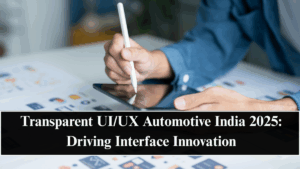The car interior is no longer just about buttons and screens — it’s about seamless interaction between human and machine. Transparent UI/UX Automotive India 2025 is redefining how drivers engage with vehicles through augmented reality (AR), gesture-based controls, and immersive interfaces that blend physical and digital experiences.
As automotive design evolves in 2025, India’s automakers and tech innovators are embracing transparency and simplicity — where every interaction feels natural, intuitive, and distraction-free.

The Shift Toward Transparent Interfaces
Traditional dashboards are giving way to AR-powered windshields, holographic displays, and voice-activated controls. The goal is to make technology invisible yet accessible — creating an experience where drivers interact with information without taking their eyes off the road.
Transparent UI (User Interface) and UX (User Experience) principles focus on:
-
Minimal visual clutter: Clean layouts and contextual displays.
-
Seamless data integration: Merging navigation, vehicle data, and media.
-
Natural control methods: Gesture, eye-tracking, and haptic feedback replacing physical buttons.
-
Personalization: AI adapting interfaces to driver habits and preferences.
By 2025, this design philosophy is shaping every aspect of connected and electric vehicles in India.
India’s Role in Automotive UI/UX Innovation
India’s growing automotive tech ecosystem is playing a central role in this design revolution. Companies like Tata Elxsi, Mahindra Advanced Design Europe (MADE), and Hyundai Mobis India are developing advanced digital cockpit systems with transparent overlays and adaptive lighting.
Indian R&D hubs are integrating AI-driven user experience design, creating smart dashboards that can anticipate driver intent — adjusting menus, climate settings, or navigation routes automatically.
Startups in Bengaluru and Pune are working on AR display modules and voice UX platforms for EVs, making India a hub for next-gen automotive interface design.
Key Technologies Behind Transparent Automotive UI/UX
-
Augmented Reality Dashboards: Project navigation, speed, and hazard alerts directly on the windshield.
-
Holographic HUDs (Heads-Up Displays): Provide layered, depth-aware data visualization without obstructing the road view.
-
Gesture and Eye-Tracking Controls: Enable hands-free control of infotainment and comfort systems.
-
Haptic Feedback Panels: Offer tactile response through vibrating surfaces or touch-sensitive panels.
-
AI-Powered Personalization: Adjusts UI brightness, font, and content placement based on user behavior and time of day.
These systems use edge computing and onboard sensors to process data locally, ensuring real-time responsiveness and minimal distraction.
Enhancing Safety and User Experience
Transparent UI/UX doesn’t just look futuristic — it enhances safety. By integrating driving data and alerts into the driver’s line of sight, reaction times are improved, and distraction levels are reduced.
For instance, AR overlays can highlight lane markings in poor visibility or display adaptive cruise control data in real time. Gesture-based controls also allow drivers to adjust volume, accept calls, or modify climate settings without looking away from the road.
In India’s traffic-dense environments, these features contribute to safer and more fluid driving experiences while maintaining a strong aesthetic appeal.
Sustainability and Design Integration
Modern automotive UX design also reflects a commitment to sustainability and minimalism. By eliminating unnecessary physical components, manufacturers reduce materials, weight, and waste.
Transparent OLED displays and flexible touch surfaces are being built into dashboards and panels, offering durability with reduced energy consumption. The focus is on crafting interiors that are both eco-friendly and technologically immersive — blending digital innovation with responsible design.
The Road Ahead: Human-Centered Transparent Design
By 2025, Transparent UI/UX Automotive India is redefining what it means to “drive.” Cars are evolving into intelligent companions that communicate through light, visuals, and voice — not complexity.
The next step is full integration between vehicle systems, wearable tech, and smartphones, creating an ecosystem where interfaces adapt dynamically across all devices.
In the coming decade, transparency won’t just be about design — it will represent trust, safety, and human-centered innovation. India is poised to lead this transformation, driving a new standard in intuitive, intelligent mobility experiences.
FAQs
What is transparent UI/UX in automotive design?
It refers to interfaces that merge physical and digital elements, using AR, gesture, and minimal visuals to make car controls intuitive and seamless.
How does transparent UI improve safety?
By projecting driving data and alerts directly in the driver’s view, it minimizes distractions and improves reaction times.
Are Indian companies working on automotive UX tech?
Yes, companies like Tata Elxsi, Mahindra, and Hyundai Mobis India are leading innovations in AR dashboards and intelligent UX systems.
What technologies power transparent automotive interfaces?
AR HUDs, gesture recognition, eye-tracking, haptic feedback, and AI-based personalization are central to transparent UI systems.
What is the future of in-car UX?
By 2030, interfaces will become adaptive ecosystems — learning from driver behavior and merging digital intelligence with physical design.
Click here to know more.
